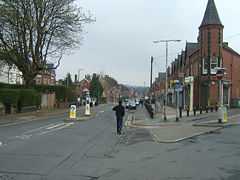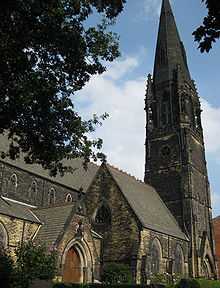Hyde Park, Leeds
| Hyde Park | |
 Brudenell Road, one of the main roads through Hyde Park |
|
 Hyde Park |
|
| OS grid reference | SE282350 |
|---|---|
| Metropolitan borough | City of Leeds |
| Metropolitan county | West Yorkshire |
| Region | Yorkshire and the Humber |
| Country | England |
| Sovereign state | United Kingdom |
| Post town | LEEDS |
| Postcode district | LS6 |
| Dialling code | 0113 |
| Police | West Yorkshire |
| Fire | West Yorkshire |
| Ambulance | Yorkshire |
| EU Parliament | Yorkshire and the Humber |
Coordinates: 53°48′41″N 1°34′21″W / 53.81141°N 1.57245°W
Hyde Park is an inner-city area of north-west Leeds, West Yorkshire, England, situated between the University of Leeds and Headingley.
It is mainly in the Hyde Park & Woodhouse ward, though some areas of what is often considered to be Hyde Park lie within the Headingley Ward (e.g. Hyde Park Picture House, Brudenell Social Club). The boundary is roughly Queens Road. The boundary between the two wards is also the boundary between Leeds Central constituency, which contains Hyde Park & Woodhouse, and Leeds North West constituency, which contains Headingley. The border between Headingley and Hyde Park is not clear: Transport Direct considers Victoria Road to be the northern limit of Hyde Park, but the Land Registry registers properties in some areas south of Victoria Road, such as Chestnut Avenue, as Headingley.
Unlike the nearby areas of Burley, Headingley and Woodhouse, Hyde Park was not historically a village so its boundaries are inevitably vague. Local people would largely consider Victoria Road, Cardigan Road, Alexandra Road (or Burley Road) and the University edge of the park, Woodhouse Moor, to be the boundaries of Hyde Park.
The area is in the centre of the city's student community. Being next to Headingley, a large student community, Hyde Park is now an established alternative student district. There are also many full-time, long-term, non-student families and single people. There is a sizable South Asian community.
Place-name
Much of the area was originally known as Wrangthorn, and this is still used in the Church of England parish name "Benefice of Woodhouse and Wrangthorn",[1] and the Church at Hyde Park Corner is Wrangthorn Church. The name Hyde Park seems to have been extended to the present area from the name of the road junction Hyde Park Corner, itself apparently named in the nineteenth century on the inspiration of Hyde Park, London. According to J. Landfear Lucas, writing in 1914,
Two suggested explanations have been offered. The first is to the effect that, in the year 1800, a farmhouse was built on the site of the present Wrangthorn Church, by Nathaniel Atkinson, whose son John carried on the farm after his father's death, the land extending from the Cardigan estate to the slopes of Woodhouse Ridge, John Atkinson and a friend or two took coach to London, and on their safe return had a meeting in the farmhouse, and over a bowlof punch solemnly gave the district the name of "Hyde Park Corner" to commemorate their pleasant visit to London. The present "Hyde Park" Hotel at Leeds was then called the "Red Lion," but its name was soon afterwards changed ... The second suggested explanation is that the builder and proprietor of certain
houses which formed the nucleus of the present Hyde Park Road in Leeds had named a new street "Henrietta" after a beloved daughter. Subsequently, however, he took a journey to London, where, to his annoyance, he found that a Henrietta Street bore an evil repute. On the other hand, Hyde Park had pleased him mightily, and on his return he substituted that appellation, and reserved "Henrietta" exclusively for his daughter.[2]
Community
In July 2005, Hyde Park became the focus of international attention as police carried out a raid connected to the 7 July 2005 London bombings. Officers used a controlled explosion to enter a property at 28 Alexandra Grove, situated roughly where the Hyde Park and Burley areas meet.[3] Hundreds of local residents were evacuated as police searched the house, one of six in West Yorkshire to be raided that day. Despite media speculation that the house had allegedly been used as a 'bomb factory' by the suicide bombers, police later said they found no explosives in the property.
The area suffers high unemployment. According to official police statistics 'Hyde Park and Woodhouse' now has one of the lowest crime rates in the city making it one of the safest neighborhoods in which to live.[4]
In July 1995 the area suffered serious rioting after the taking over of a local pub, The Newlands, by the police to be used in surveillance.[5][6] The local community rallied and created Unity Day,[7] a popular community festival started by the Hyde Park Residents Association held on the adjacent Woodhouse Moor, usually in August. The non-student community is vibrant, artsy and centres around Unity Day, Friends of Woodhouse Moor, Royal Park Community Consortium and other groups.
Amenities

The area is home to the Leeds Grand Mosque, the largest in Leeds,[8] one Hindu temple and two Anglican churches and Our Lady of Lourdes Church on the Cardigan Road. Alongside outlets primarily catering for the student population there remain a number of smaller shops selling largely traditional South Asian goods. This arguably lessens the impact of studentification, though some community groups do consider this to be a problem and tension exists.[9]
Hyde Park is the home of the Hyde Park Picture House, an independent, historic, art house cinema. The Royal Park, on Queen's Road, is a large pub with a downstairs gig venue, popular with the student population, and next door stands the Brudenell Social Club, a members' club which has recently taken on a new role as a venue for local and underground music.
There are also a number of cafes and shops at Hyde Park Corner, including a vintage and antiques store and a Greek cafe. The area has many local or independent shops, such as DIY stores, takeaways, fruit and vegetable shops, a small Sainsbury's, Coop and two independent mini supermarkets, a pharmacy, a laundrette, a bakers on Cardigan Road and three vintage clothes stores.
The area is close to Burley railway station and benefits from good bus links into the city centre and North Leeds, which makes the area popular with young professionals/workers.
Woodhouse Moor is also one of the most used parks in the city.
Housing
The majority of residential properties in the area are late Victorian and Edwardian back-to-back brick terraces or face onto wide streets with communal access alleyways at the rear. A small area of 1980s council housing lies between Hyde Park Road and Woodsley Road, these replaced terrace housing demolished due to slum clearance. Main roads are cambered and some still retain original Yorkstone pavements and iron guttering. However, Leeds City Council have been removing much of the stone paving and granite kerbs to be replaced by modern tarmac and concrete. A large number of houses in Hyde Park are owned by private landlords who rent to students.
Notable residents
- Swallows and Amazons author Arthur Ransome was born in the area: a blue plaque on No 6 Ash Grove commemorates this.[10]
- Singer Ricky Wilson, of the band Kaiser Chiefs, lived in Hyde Park whilst a student at Leeds Metropolitan University.Ricky Wilson still lives nearby.
- Singer Corinne Bailey Rae lived here.
- Actor Chris Pine, famous for playing Captain James T. Kirk in the film Star Trek lived on Brudenell Road, whilst studying on a year abroad at the University of Leeds.
- Cricketer Hedley Verity,(1905–1943) a left-arm bowler, was born in Welton Grove; he played over 300 matches for Yorkshire and in 40 test matches for England.[11]
Chestnut Avenue
Chestnut Avenue in Hyde Park was the subject of many articles in 2001/02, including one in the Daily Mail asking Is this the most burgled street in Britain?.[12] This is not shown in the police statistics[13] but the high student population with many valuable items in their houses are a common target for criminals. In fact, references to its being, 'The most-burgled street in Britain' go back as far as at least 1993. This has since been lessened by fitting a gate to the back lane of Chestnut Avenue.
References
- ↑ http://www.achurchnearyou.com/benefice.php?B=30/204BM&V=3341
- ↑ J. Landfear Lucas, 'Hyde Park Corner, Leeds', Notes and Queries, s11-IX (219) (1914), 185-86. DOI: 10.1093/nq/s11-IX.219.185-b.
- ↑ BBC News coverage of the suspected 'bomb factory
- ↑ , Official Police statistics
- ↑ Davies, Nick Dark Heart: The Shocking Truth About Hidden Britain, Vintage ISBN 0-09-958301-1
- ↑ Foster, Jonathan (12 July 1995). "Leeds riot blamed on police crime crackdown". The Independent. Retrieved 12 November 2013.
- ↑ Unity Day a festival held in Hyde Park
- ↑ The Times 24 August 2002, Daniel Crewe "At Your Service"
- ↑ List of local residents groups concerned with Landlordism and Studentification from the Heal Headingley Website
- ↑ Avery, Gillian (2004). "Ransome, Arthur Michell (1884–1967)". Oxford Dictionary of National Biography. Retrieved 2008-06-11. (subscription required (help)).
- ↑ Oxford Dictionary of National Biography, accessed 8 May 2011
- ↑ Heal Headingley National Newspapers Archive 22.5.02
- ↑ Labour website, "Chestnut Avenue has been previously reported as ‘most burgled street in Britain’. Although this is disputed by police"
External links
| Wikimedia Commons has media related to Hyde Park, Leeds. |